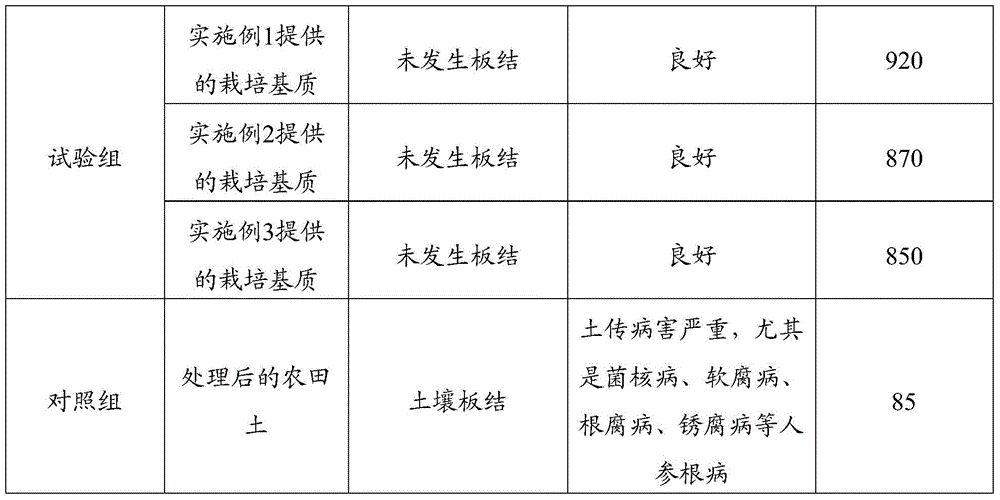Cultivation substrate and preparation method thereof, and planting method of ginseng
A cultivation substrate and ginseng technology, applied in the agricultural field, can solve the problems of biodiversity, the reduction of biomass forest ecological benefits, the loss of habitat environment for rare species, and the reduction of natural disaster defense capabilities, so as to avoid excessive heavy metals and reduce pesticide residues , the effect of preventing soil-borne diseases
- Summary
- Abstract
- Description
- Claims
- Application Information
AI Technical Summary
Problems solved by technology
Method used
Image
Examples
Embodiment 1
[0053] The preparation of embodiment 1 cultivation medium
[0054] Collect the discarded bacteria sticks, peel the bags through the bag stripping machine, and pour them into the fermentation tank. For each fermentation tank, put 200 cubic meters of discarded bacteria sticks at a time. At the same time, put 100kg of quicklime, 500g of yeast, and 200g of compound bacillus. After 60 days of anaerobic fermentation (flooding), add 2.5kg of chlorothalonil, 150g of Hymexazol is sterilized, and then dried, pulverized, and sieved (40 mesh) to obtain organic materials.
[0055] Grind peat soil, live loess, bone meal and potassium sulfate, and set aside.
[0056] Take 400kg of the above-mentioned organic material, 350kg of peat soil, 200kg of live loess, 80kg of bone meal, and 20kg of potassium sulfate and add them into a mixer and mix them evenly to obtain final product.
[0057] The nutrient content of the cultivation substrate prepared above was measured, and the results are shown i...
Embodiment 2
[0060] Example 2 Preparation of cultivation substrate
[0061] Collect the discarded bacteria sticks, peel the bags through the bag stripping machine, and pour them into the fermentation tank. In each fermentation tank, put 300 cubic meters of discarded bacteria sticks at a time, and at the same time, put 120kg of quicklime, 400g of yeast, and 100g of compound bacillus. After 70 days of anaerobic fermentation, add 2.8kg of chlorothalonil and 200g of hymexazol for Sterilize, dry, pulverize and sieve (40 mesh) to obtain organic materials.
[0062] Grind peat soil, live loess, bone meal and potassium sulfate, and set aside.
[0063] Take 300kg of the above-mentioned organic material, 450kg of peat soil, 200kg of live loess, 50kg of bone meal, and 20kg of potassium sulfate and add them into a mixer and mix them evenly to obtain final product.
Embodiment 3
[0064] Example 3 Preparation of Cultivation Substrate
[0065] Collect the discarded bacteria sticks, peel the bags through the bag stripping machine, and pour them into the fermentation tank. In each fermentation tank, put 150 cubic meters of discarded bacteria sticks at a time. At the same time, put 150kg of quicklime, 600g of yeast, and 400g of compound bacillus. After 80 days of anaerobic fermentation, add 3.0kg of chlorothalonil and 100g of hymexazol for Sterilize, dry, pulverize and sieve (40 mesh) to obtain organic materials.
[0066] Grind peat soil, live loess, bone meal and potassium sulfate, and set aside.
[0067] Take 500kg of the above-mentioned organic material, 250kg of peat soil, 100kg of live loess, 60kg of bone meal, and 20kg of potassium sulfate, and add them into a mixer and mix evenly to obtain final product.
PUM
 Login to View More
Login to View More Abstract
Description
Claims
Application Information
 Login to View More
Login to View More - R&D
- Intellectual Property
- Life Sciences
- Materials
- Tech Scout
- Unparalleled Data Quality
- Higher Quality Content
- 60% Fewer Hallucinations
Browse by: Latest US Patents, China's latest patents, Technical Efficacy Thesaurus, Application Domain, Technology Topic, Popular Technical Reports.
© 2025 PatSnap. All rights reserved.Legal|Privacy policy|Modern Slavery Act Transparency Statement|Sitemap|About US| Contact US: help@patsnap.com



